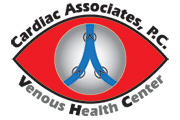 May-Thurner syndrome is a rare condition in which the iliofemoral vein (one of the deep-lying veins in the body) becomes compressed by an overlying companion artery. Also called ileo-caval compression syndrome or outflow venous obstruction, this condition occurs as an anatomical defect where the left iliac vein compresses against the right iliac artery. May-Thurner syndrome causes an increased risk for deep vein thrombosis (DVT), a condition in which a blood clot partially of fully blocks off the flow of blood through the vein.
May-Thurner syndrome is a rare condition in which the iliofemoral vein (one of the deep-lying veins in the body) becomes compressed by an overlying companion artery. Also called ileo-caval compression syndrome or outflow venous obstruction, this condition occurs as an anatomical defect where the left iliac vein compresses against the right iliac artery. May-Thurner syndrome causes an increased risk for deep vein thrombosis (DVT), a condition in which a blood clot partially of fully blocks off the flow of blood through the vein.
Many people are unaware that they have this condition until they discover DVT; however, May-Thurner syndrome can be symptomatic. Common symptoms of May-Thurner syndrome can include swelling in the lower body, pain and tenderness in the leg, redness, feverish skin and enlarged leg veins (varicose veins). Because the condition is chronic, people who have May-Thurner syndrome are prone to recurring DVT and skin ulcers on the legs and ankles.
While uncomfortable, May-Thurner syndrome is not usually deadly, although DVT can be a health risk if the clot breaks free from the vein wall and blocks off blood flow to the heart and lungs. In these instances, pulmonary embolism or heart attack can occur, which can be debilitating or life threatening. It is important to seek treatment for this condition from a Washington DC vein specialist early on before the condition worsens and becomes a larger medical concern.
At your visit to the top vein center in Montgomery County, we will use state-of-the-art diagnostic and treatment modalities to locate and treat the root of your problem. Some of these tools include Doppler ultrasound and various venogram techniques. The goal of treatment is targeted at getting rid of any existing blood clots, preventing disease progression and correcting the underlying compression of the iliac vein.


